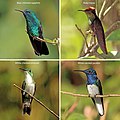Hummingbird
Hummingbird is a type of bird known for its small size, rapid wing flapping, and ability to hover in mid-air. They are native to the Americas and are the smallest of birds, most species measuring 7.5–13 cm (3–5 in) in length. The smallest extant bird species is a hummingbird, the 5 cm (2.0 in) bee hummingbird, which weighs less than 2.0 g (0.07 oz).
Characteristics[edit]
Hummingbirds have many physical characteristics that distinguish them from other birds. They have a specialized long and straight bill that is used to extract nectar from the center of long, tubular flowers. The hummingbird's tongue, which is long and can be extended beyond the length of the bill, is used to extract nectar from flowers.
Hummingbirds are known for their unique flight capabilities. They can fly at speeds exceeding 15 m/s (54 km/h; 34 mph); they are also the only group of birds with the ability to fly backwards. The hummingbird's rapid wing flapping rate, typically around 50 times per second, allows them to hover in mid-air, a feature that is unique among birds.
Diet[edit]
The primary component of the hummingbird's diet is nectar, a sweet liquid inside certain flowers. They also eat insects and spiders, especially when feeding young. Hummingbirds are attracted to brightly colored flowers, which they can see better than other birds due to their ability to perceive ultraviolet light.
Reproduction[edit]
Hummingbirds are solitary in all aspects of life other than breeding; and the male's only involvement in the reproductive process is the actual mating with the female. They lay the smallest eggs of all birds, with an average mass of 1 g (0.035 oz), or about 10% of the weight of a human baby at birth.
Conservation[edit]
Many species of hummingbirds are currently threatened with extinction, primarily due to habitat loss and destruction. Conservation efforts are being made to protect these species, but their small size and rapid metabolism make them particularly vulnerable to changes in their environment.
See also[edit]
|
|
|
-
Trinidad and Tobago hummingbirds composite
-
Mellisuga helenae Size Comparison
-
Bee hummingbird (Mellisuga helenae) adult male non-breeding
-
Ruby Throated Hummingbird, F, leg, 430 ESt. NW, 8.22.12
-
Allen's hummingbird on nest
-
Allen's Hummingbird Nest
-
Friday's Hummingbird Nest
-
Archilochus colubris (Male)
-
Purple-throated carib hummingbird feeding
-
Colibri thalassinus
-
Violet-tailed Sylph
-
Violet-tailed Sylph (female)
Ad. Transform your life with W8MD's Budget GLP-1 injections from $75


W8MD offers a medical weight loss program to lose weight in Philadelphia. Our physician-supervised medical weight loss provides:
- Weight loss injections in NYC (generic and brand names):
- Zepbound / Mounjaro, Wegovy / Ozempic, Saxenda
- Most insurances accepted or discounted self-pay rates. We will obtain insurance prior authorizations if needed.
- Generic GLP1 weight loss injections from $75 for the starting dose.
- Also offer prescription weight loss medications including Phentermine, Qsymia, Diethylpropion, Contrave etc.
NYC weight loss doctor appointmentsNYC weight loss doctor appointments
Start your NYC weight loss journey today at our NYC medical weight loss and Philadelphia medical weight loss clinics.
- Call 718-946-5500 to lose weight in NYC or for medical weight loss in Philadelphia 215-676-2334.
- Tags:NYC medical weight loss, Philadelphia lose weight Zepbound NYC, Budget GLP1 weight loss injections, Wegovy Philadelphia, Wegovy NYC, Philadelphia medical weight loss, Brookly weight loss and Wegovy NYC
|
WikiMD's Wellness Encyclopedia |
| Let Food Be Thy Medicine Medicine Thy Food - Hippocrates |
Medical Disclaimer: WikiMD is not a substitute for professional medical advice. The information on WikiMD is provided as an information resource only, may be incorrect, outdated or misleading, and is not to be used or relied on for any diagnostic or treatment purposes. Please consult your health care provider before making any healthcare decisions or for guidance about a specific medical condition. WikiMD expressly disclaims responsibility, and shall have no liability, for any damages, loss, injury, or liability whatsoever suffered as a result of your reliance on the information contained in this site. By visiting this site you agree to the foregoing terms and conditions, which may from time to time be changed or supplemented by WikiMD. If you do not agree to the foregoing terms and conditions, you should not enter or use this site. See full disclaimer.
Credits:Most images are courtesy of Wikimedia commons, and templates, categories Wikipedia, licensed under CC BY SA or similar.
Translate this page: - East Asian
中文,
日本,
한국어,
South Asian
हिन्दी,
தமிழ்,
తెలుగు,
Urdu,
ಕನ್ನಡ,
Southeast Asian
Indonesian,
Vietnamese,
Thai,
မြန်မာဘာသာ,
বাংলা
European
español,
Deutsch,
français,
Greek,
português do Brasil,
polski,
română,
русский,
Nederlands,
norsk,
svenska,
suomi,
Italian
Middle Eastern & African
عربى,
Turkish,
Persian,
Hebrew,
Afrikaans,
isiZulu,
Kiswahili,
Other
Bulgarian,
Hungarian,
Czech,
Swedish,
മലയാളം,
मराठी,
ਪੰਜਾਬੀ,
ગુજરાતી,
Portuguese,
Ukrainian














